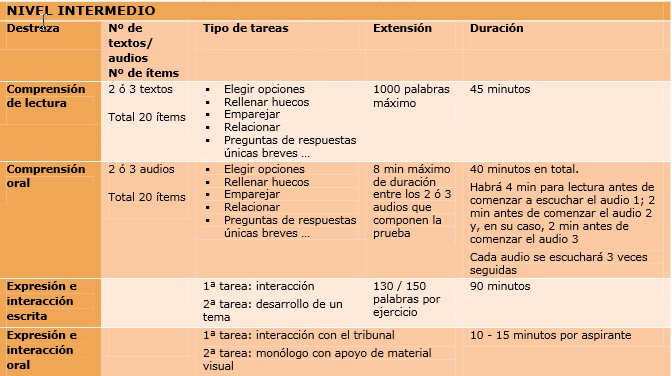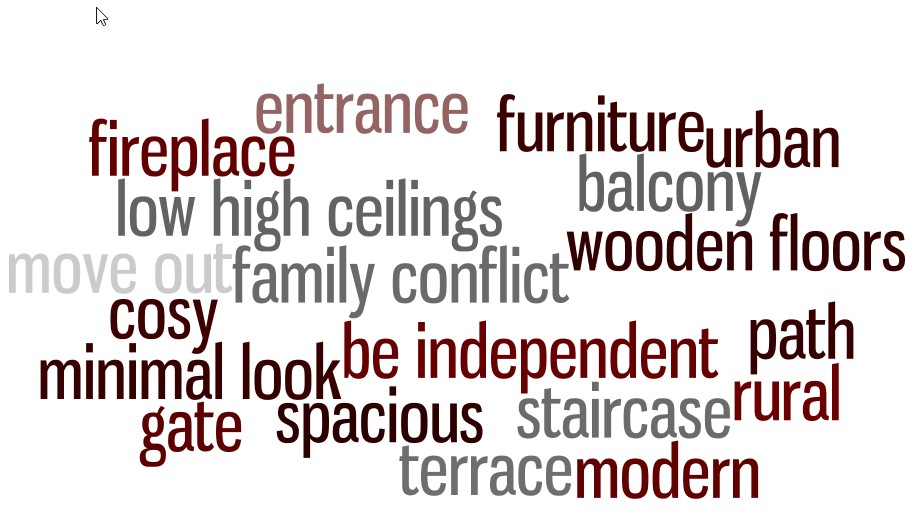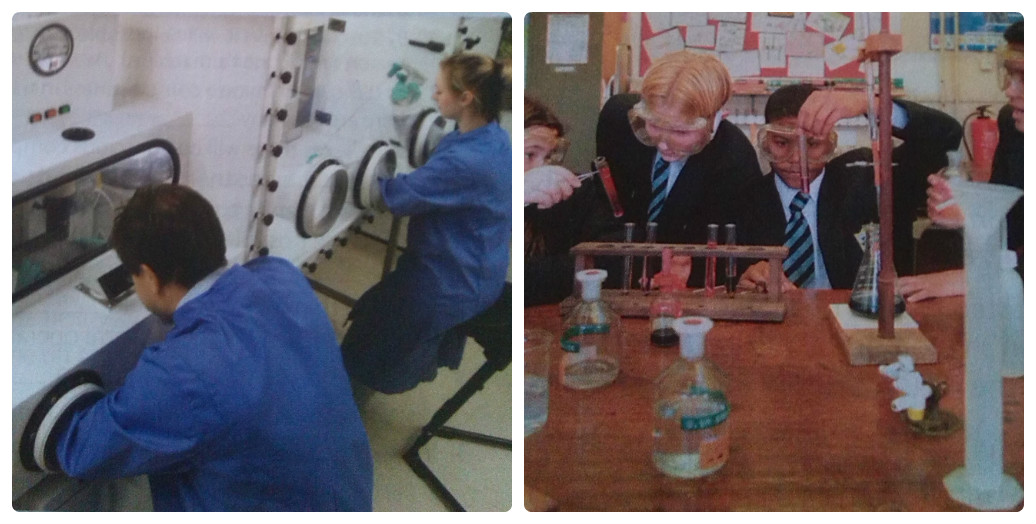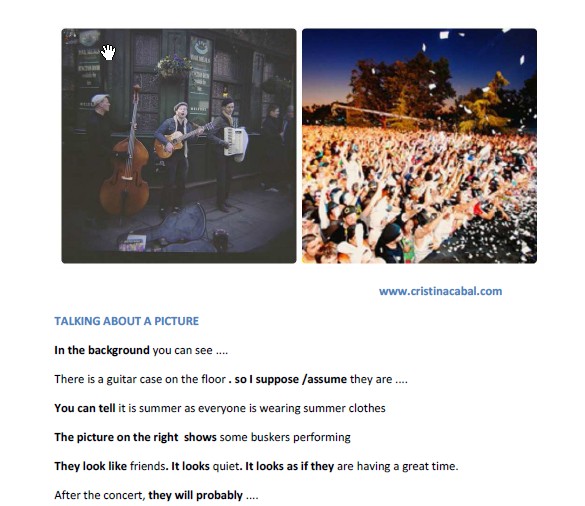
The SPEAKING TEST consta de tres partes .
- En la primera parte ,(1 ó 2 m) el examinador hará preguntas de carácter general cuyas respuestas no contarán de cara a la nota final. No tiene otro objetivo que ayudar a que el alumno se sienta más cómodo.
- La segunda parte del examen es la INTERACCIÓN . En esta parte el examinador interactuará con el alumno. En el Nivel Básico, se le dará al alumno una situación (role-play) donde tendrá que asumir el papel que se le indique. En el Nivel Intermedio , el examinador elegirá un tema y hará preguntas al candidato.
- La tercera parte del examen es lo que denomina DISCURSO CONTINUO . Aquí el candidato tendrá que hablar sobre unas fotografías ( máximo tres) sin ninguna intervención por parte del examinador . En el Nivel Básico se pedirá al candidato que compare y describa , y en el Nivel Intermedio que describa y compare las fotos y hablé ,además ,sobre el tema sugerido en las mismas.
ALGUNOS CONSEJOS SOBRE EL EXAMEN ORAL.
El examen oral es tu oportunidad de brillar .El examinador espera de ti que utilices variedad de estructuras y vocabulario adecuado al nivel del que te examinas. Si estás en Intermedio y utilizas vocabulario y estructuras de Nivel básico , aunque no tengas errores no es probable que apruebes . Es importante que respondas a las preguntas del examinador con respuestas largas, desarrollando tus ideas. No esperes a que el examinador te pregunte “por qué” a una pregunta que te ha realizado, lo normal es que tu ofrezcas esa explicación y que el profesor no necesite aclaración ninguna. No te olvides además de usar conectores para enlazar tus ideas, no utilices siempre los mismos , recuerda que es tu momento de brillar.
Mira este video. Ilustra muy bien lo que intento explicarte arriba.
En el examen oral , como ya te he explicado, tienes que utilizar variedad de estructuras . Mira este video de 5 m para aprender diferentes expresiones para substituir I like/ I don’t like. Aquí
Enlaces a páginas que pueden ayudarte a preparar el examen
NIVEL BASICO
♥EXAMEN ORAL
DESCRIPCION DE FOTOGRAFIAS
1. Blog de Cristina .Descripción de personas , Descripcion de una foto
2. Writefix.com . Al pasar el cursor por encima de las fotos, te ofrece sugerencias de vocabulario y estructuras para ayudarte a describir.La sección se llama PET SPEAKING.
3. El British Council en su web , publica un video donde dos estudiantes describen una fotografia . Video aqui, tapescript aqui
4. Blog de Cristina. Ejemplos de descripcion de fotografias realizadas por alumnos de la EOI
aquí y aqui
ROLE PLAYS
1. Blog de Cristina con ejemplos ( algunas interactivos) de distintos role-plays. Aquí
2. Twominenglish.com. Videos para practicar role-plays : at the restaurant, shopping or at the airport. Repetiras las frases más comunes para cada una de estas situaciones.
3. http://simpleesl.com/coleccion de 16 role-plays para continuar practicando
♥READING
Esl-bits.net. Haz clic en uno de los Tests ( numerados del 1 al 19 ) y elije que tipo de ejercicio quieres hacer (signs,details,matching..,)
NIVEL INTERMEDIATE
♥SPEAKING
INTERACCIÓN
1 Blog de Cristina. Temas variados acompañados de fotografias .
2. Eslconversationquestions.com/
3. Teflpedia.com/
4. En Ielts Speaking puedes preparar 16 temas de examen (Towns and Cities, Clothes and fashion…etc ) . Leerás las preguntas que hacen los examinadores y las respuestas que a los examinadores les gustaría oir con el vocabulario especifico marcado en negrita.
5.En Digilander.libero.it/puedes ver algunas Useful expressions for the speaking exam que tal vez te sirvan de ayuda.
♥READING
1. The British Council en su sección para teens puede ayudarte
2. Blog de Cristina . Sección Reading (scroll down)
♥WRITING
WriteFix.com ofrece ejemplos de expresión escrita . Solapa CAUSE AND EFFECT:HOME y ESSAY LIST OLDER.
Blog de Cristina. Sección de writing ( scroll down)
Espero haberte ayudado. Si conoces algun enlace que pueda resultar útil para preparar este examen no dudes en mandármelo
NO OLVIDES INSCRIBIRTE!
 In this post you’ll find some material to practise describing two pictures about Houses/Rooms in a House. There is some useful vocabulary and expressions as well as two different sets of pictures with some questions that might give you some ideas of what you need to talk about in this part of the exam. Remember that you’ll need to practise describing , comparing and giving opinion . Download the pdf here
In this post you’ll find some material to practise describing two pictures about Houses/Rooms in a House. There is some useful vocabulary and expressions as well as two different sets of pictures with some questions that might give you some ideas of what you need to talk about in this part of the exam. Remember that you’ll need to practise describing , comparing and giving opinion . Download the pdf here Useful Expressions:
Useful Expressions: Some ideas to help you:
Some ideas to help you: Some ideas to help you:
Some ideas to help you:

 It was early October and, at that time, the course seemed long enough to last a lifetime, and just now I ‘ve realized that spring is technically here, in fact, it ‘s been here for several days though I don’t feel exactly in on spring-mode and… it doesn’t help that it’s been raining on and off for the last few days. 🙁
It was early October and, at that time, the course seemed long enough to last a lifetime, and just now I ‘ve realized that spring is technically here, in fact, it ‘s been here for several days though I don’t feel exactly in on spring-mode and… it doesn’t help that it’s been raining on and off for the last few days. 🙁 Some ideas to help you talk:
Some ideas to help you talk:
